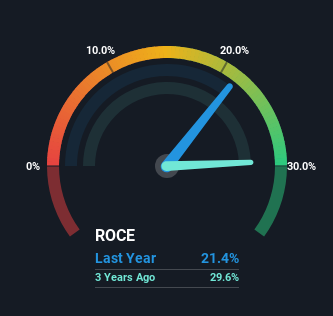Investors Could Be Concerned With Shanghai Bolex Food Technology's (SHSE:603170) Returns On Capital

To find a multi-bagger stock, what are the underlying trends we should look for in a business? Firstly, we'll want to see a proven return on capital employed (ROCE) that is increasing, and secondly, an expanding base of capital employed. Basically this means that a company has profitable initiatives that it can continue to reinvest in, which is a trait of a compounding machine. So while Shanghai Bolex Food Technology (SHSE:603170) has a high ROCE right now, lets see what we can decipher from how returns are changing.
What Is Return On Capital Employed (ROCE)?
For those who don't know, ROCE is a measure of a company's yearly pre-tax profit (its return), relative to the capital employed in the business. Analysts use this formula to calculate it for Shanghai Bolex Food Technology:
Return on Capital Employed = Earnings Before Interest and Tax (EBIT) ÷ (Total Assets - Current Liabilities)
0.21 = CN¥288m ÷ (CN¥1.7b - CN¥373m) (Based on the trailing twelve months to September 2023).
Thus, Shanghai Bolex Food Technology has an ROCE of 21%. That's a fantastic return and not only that, it outpaces the average of 8.2% earned by companies in a similar industry.
See our latest analysis for Shanghai Bolex Food Technology

In the above chart we have measured Shanghai Bolex Food Technology's prior ROCE against its prior performance, but the future is arguably more important. If you'd like to see what analysts are forecasting going forward, you should check out our free analyst report for Shanghai Bolex Food Technology .
What Does the ROCE Trend For Shanghai Bolex Food Technology Tell Us?
In terms of Shanghai Bolex Food Technology's historical ROCE movements, the trend isn't fantastic. To be more specific, while the ROCE is still high, it's fallen from 38% where it was four years ago. However, given capital employed and revenue have both increased it appears that the business is currently pursuing growth, at the consequence of short term returns. And if the increased capital generates additional returns, the business, and thus shareholders, will benefit in the long run.
On a side note, Shanghai Bolex Food Technology has done well to pay down its current liabilities to 22% of total assets. That could partly explain why the ROCE has dropped. Effectively this means their suppliers or short-term creditors are funding less of the business, which reduces some elements of risk. Since the business is basically funding more of its operations with it's own money, you could argue this has made the business less efficient at generating ROCE.
The Bottom Line
Even though returns on capital have fallen in the short term, we find it promising that revenue and capital employed have both increased for Shanghai Bolex Food Technology. And there could be an opportunity here if other metrics look good too, because the stock has declined 35% in the last year. So we think it'd be worthwhile to look further into this stock given the trends look encouraging.
If you want to know some of the risks facing Shanghai Bolex Food Technology we've found 2 warning signs (1 shouldn't be ignored!) that you should be aware of before investing here.
If you want to search for more stocks that have been earning high returns, check out this free list of stocks with solid balance sheets that are also earning high returns on equity.
New: Manage All Your Stock Portfolios in One Place
We've created the ultimate portfolio companion for stock investors, and it's free.
• Connect an unlimited number of Portfolios and see your total in one currency
• Be alerted to new Warning Signs or Risks via email or mobile
• Track the Fair Value of your stocks
Have feedback on this article? Concerned about the content? Get in touch with us directly. Alternatively, email editorial-team (at) simplywallst.com.
This article by Simply Wall St is general in nature. We provide commentary based on historical data and analyst forecasts only using an unbiased methodology and our articles are not intended to be financial advice. It does not constitute a recommendation to buy or sell any stock, and does not take account of your objectives, or your financial situation. We aim to bring you long-term focused analysis driven by fundamental data. Note that our analysis may not factor in the latest price-sensitive company announcements or qualitative material. Simply Wall St has no position in any stocks mentioned.
About SHSE:603170
Shanghai Bolex Food Technology
Engages in the research, development, production, and sales of condiments and pre-cooked food in China and internationally.
Flawless balance sheet and good value.
Market Insights
Community Narratives



